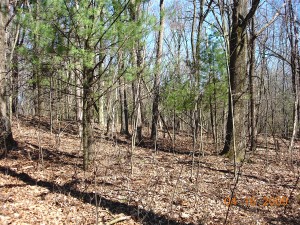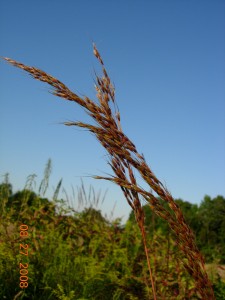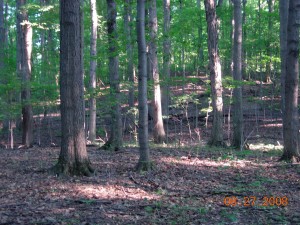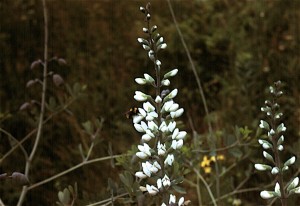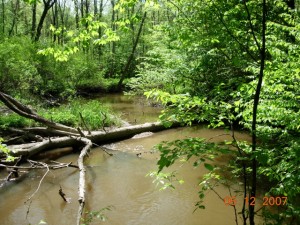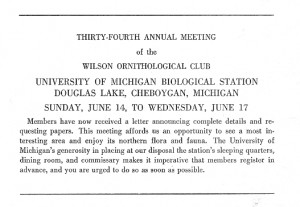 When I arrived at Western Michigan University in 1959, Michigan was in the midst of an ornithological Golden Age. Dozens of ornithologists were practicing their science in the state or had recent (or soon-to-come) connections. Nearly every college and university had one to several faculty members with a special interest in birds.
When I arrived at Western Michigan University in 1959, Michigan was in the midst of an ornithological Golden Age. Dozens of ornithologists were practicing their science in the state or had recent (or soon-to-come) connections. Nearly every college and university had one to several faculty members with a special interest in birds.
My first exposure to Michigan had come in 1953 while I was still an undergraduate at Southern Illinois University. I attended the 34th annual Wilson Ornithological Society meeting held at the University of Michigan Biological Station at Douglas Lake. Among the 123 Michigan residents at that meeting (out of 350 total attendees) were many faculty members including Andy Berger, Harry Hann, Bob Storer, Josselyn Van Tyne, George Wallace, Miles Pirnie, Lew Batts, and Nick Cuthbert. Such redoubtable graduate students as Philip Humphrey, Peter Stettenheim, Dale Zimmerman, and John William Hardy were also registered.
Hardy, my friend since childhood, was doing a master’s degree with George Wallace at Michigan State and had arranged a ride for us from East Lansing to the Bio Station with T. Wayne Porter. Porter was an invertebrate zoologist but also had broad natural history interests that included birds.
Also at the meeting were Sewall Pettingill, who most summers between 1938 and 1974 taught ornithology at the Bio Station; S. Charles Kendeigh who had filled in for Pettingill in 1946 and who would be my graduate advisor at the University of Illinois a couple of years later; and Theodora Nelson of Hunter College, Pettingill’s assistant 1938-1940. At this meeting she led off the first papers session with a history of ornithology at the station.
These ornithologists were at colleges and universities, though the Michigan Department of Conservation also had some academically trained ornithologists. But Michigan at this time also had a large contingent of amateurs with strong and essentially professional interests in birds. Larry Walkinshaw was one of these. Larry was at the 1953 meeting and in fact on the program not long after Teddy Nelson, giving the participants an introduction to northern Michigan birding areas.
All this history is the preamble to mentioning a new book, On the Wings of Cranes: Larry Walkinshaw’s Life Story. The biography was written by Walkinshaw’s son-in-law, Lowell M. Schake. I reviewed the book for the Wilson Journal of Ornithology (formerly Wilson Bulletin) in the June issue 2009 (vol. 121, no. 2): 445-447.
Walkinshaw was a student of birds from boyhood, but when the time for college arrived, he decided it would be wiser to study teeth instead. While at dental school at the University of Michigan, he often talked with Josselyn VanTyne, curator of birds at the Museum of Zoology. Van Tyne was only two years older but was Larry’s mentor, encouraging his interest in ornithological research. He did the same with others, notably Harold Mayfield (who also attended the 1953 meeting).
In 1929, Walkinshaw got his DDS and opened a dental office in Battle Creek not many miles west of where he grew up in Calhoun County. Over the years until he closed his practice in 1968, he combined dentistry with ornithology in a way that did not slight one in favor of the other, though the combination was not wholly satisfying either.
In summer, Wallkinshaw would get up early, make a couple of hours of observations on whatever local bird species was occupying his attention, get to his office for his first appointment at 8 AM, put in a full day, and then spend much of the time after dinner making more observations or working on manuscripts. He was dedicated not just to learning the details of avian life history but also to putting the knowledge into print. By the end of his life in 1993, he had published 9 books and something over 300 articles, chapters, and reviews. Many of these are research papers based on his painstaking observations of Field Sparrows, Sandhill Cranes, Kirtland’s Warblers, Prothonotary Warblers, and Empidonax flycatchers, among other species.
In Larry’s proposal of marriage to Clara May Cartland, he asked her if she thought she could love birds as much as he did. Whether she did or not, her abilities in running the household, helping in the dental office, and taking care of the children were probably essential to many of Larry’s ornithological accomplishments.
Besides his basic research in ornithology, Larry was heavily involved in bird conservation. He helped establish the Michigan Audubon Society’s Baker Sanctuary in Calhoun County, which brought back the Sandhill Crane as a nesting bird in southern Michigan. His observations on crane life history were important in starting the species on its road to recovery throughout its range. He was also heavily involved–much more so than the standard literary sources show– in recovery efforts for the Whooping Crane. And his observations on Kirtland’s Warblers provided many of the life history and ecology keys needed to bring that species back from near extinction.
The book provides information on these and other ornithological and conservation topics along with facts about Larry and Clara’s life in Battle Creek and at the summer cabins they had on the Lake Michigan shore near Muskegon.
Not long after my review of the book appeared, I received an email from a Canadian birder with a Walkinshaw anecdote. As a teenager 58 years ago, Fred Helleiner along with a friend had stopped at Walkinshaw’s dental office, needing directions to Baker Sanctuary. “Although we came in unannounced and decidedly scruffy, Dr. Walkinshaw’s receptionist was obviously expected to call him out to the waiting room whenever a birder arrived. On that occasion, he interrupted the treatment that he was administering to his patient…while he spent twenty or more minutes with us in his ‘gentle and patient’ (to use your words) manner providing us with the information that we needed.”
Larry Walkinshaw was gentle and patient. Helpful also. And he loved birds. A lot.

